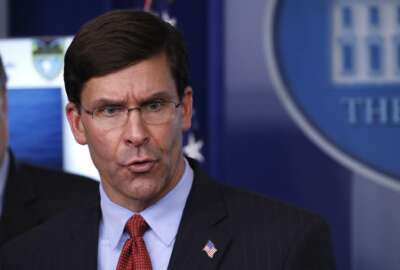
Air Force adjusting operations to account for long-term COVID fight
Air Force Chief of Staff David Goldfein has told his service to prepare for a "new abnormal." He wants the service to be able to conduct its missions even with the...
The Air Force is getting ready to make major changes to how it conducts its missions to account for what its top officers calls “the new abnormal”: the possibility that the service will need to continue operating for a year or more with perhaps as much of a fifth of the force infected with coronavirus at any one time.
Gen. David Goldfein, the Air Force chief of staff, said the service is making plans “reset” itself to new ways of operating on June 1. Commanders will need to draw up plans to reinstate some of the activities that have been paused during the initial months of the pandemic, and find ways to get back to day-to-day operations as safely as possible.
“The new abnormal is what I’m defining as living and operating with a cyclical virus until we get a vaccine,” he told reporters Wednesday. “All the projections are no vaccine for upwards of a year. So that means we’ve got to refine our ability to survive and operate and do the missions the nation require, and we’ve got to bring back those missions that we’ve slowed down so we can get back to some kind of a sense of new normalcy in an abnormal world.”
And the Air Force has already made some adaptations, especially amongst the crews responsible for what the service considers its no-fail missions, like nuclear deterrence. Airmen who staff ICBM sites have been divided into “blue” and “silver” teams that are kept isolated from one another. And instead of rotating through shifts every three-or-four hours, a single team stays in place for closer to 14 hours to lower the chances of virus spread.
So far, Goldfein said, measures like that appear to have been working. There have been no positive cases among those nuclear missile crewmembers so far.
The Air Force has been similarly protective of its air mobility crews, in part, because it expects the demand for strategic airlift to only increase the longer the pandemic drags on.
“Air Mobility Command has put in protocols and procedures where we essentially isolate the crew, keep them in a clean environment, make sure that the cockpit itself is clean so they’re able to fly the mission,” Goldfein said. “Once they land and then have to go into crew rest, we keep them isolated. We keep them in a bubble. Whatever needs to get to them is delivered, and then we keep them that way so they can keep flying all the way through coming home.”
Read more: Defense News
As part of the reset, the Air Force is looking for other ways to maintain a “breadth and depth” of personnel across other vital mission areas as well, including space, cyber, intelligence, and medicine.
But no matter the mission area, the service — like its sister services — faces a fundamental challenge in maintaining the personnel levels it needs: a relative shortage of incoming recruits.
No critical retention shortfalls yet
The Air Force is still bringing new airmen into boot camp – indeed, it’s opened a second one at Keesler Air Force Base to help increase social distancing during basic training. But even with the addition of that second location to augment Joint Base San Antonio-Lackland, the Air Force’s training pipeline is still only operating at about 50 percent of its usual capacity.
Goldfein said the service hasn’t seen any serious shortfalls within any particular career field so far.
“We are anticipating we will see that in the future if we’re not able to dial the rheostat up on the numbers going through the pipeline, but we’re not seeing any that are at critical state yet,” he said. “What’s also helpful is that retention numbers are going up. Not surprisingly, with the economy being in a challenging state, companies are not hiring as quickly. Airlines are not flying as much. So we’re actually seeing our retention numbers go up, which somewhat mitigates the lack of throughput through basic training.”
Read more: Workforce News
Goldfein said some of the changes the Air Force is making now in response to the pandemic are likely to be enduring — at least he hopes so.
Like other parts of the government, it’s been forced to use online conferencing platforms to replace large meetings, but that’s meant that gatherings that used to take weeks to plan can be put together in a matter of hours. Similarly, educational institutions like the Air Force Academy had to quickly move toward distance learning.
“We learned a ton about distance learning and how you present education in a different way,” he said. “So there are some things that, quite frankly, I hope we never go back to the previous era in terms of how we’re delivering content. We’re upping our game in terms of professional military education and how we’re using some of the new tools associated with that.”
But at least in the short-to-medium term, across all of its functions, the Air Force needs to prepare itself to operate in a world where another COVID outbreak could be “just around the corner,” Goldfein said.
“The good news is this is actually part of Air Force culture,” he said. “Ability to survive and operate (ATSO) is part of our DNA. We have trained to operate in chemical, biological, radiological environments; it’s part of who we are. So this in some ways is an opportunity to go back to our roots on ATSO and really think through how we operate. How do we look at every base which is unique and different, and not apply one size fits all but rather have that local installation commander look at that base and determine, ‘Okay, what areas are clean? What areas have to be clean? What areas do not?’ It’s a hugely diverse mission set that we’re responsible for. And now we’re working through how we operate in the new abnormal, and that’s our 1 June reset target.”
Copyright © 2024 Federal News Network. All rights reserved. This website is not intended for users located within the European Economic Area.
Jared Serbu is deputy editor of Federal News Network and reports on the Defense Department’s contracting, legislative, workforce and IT issues.
Follow @jserbuWFED





